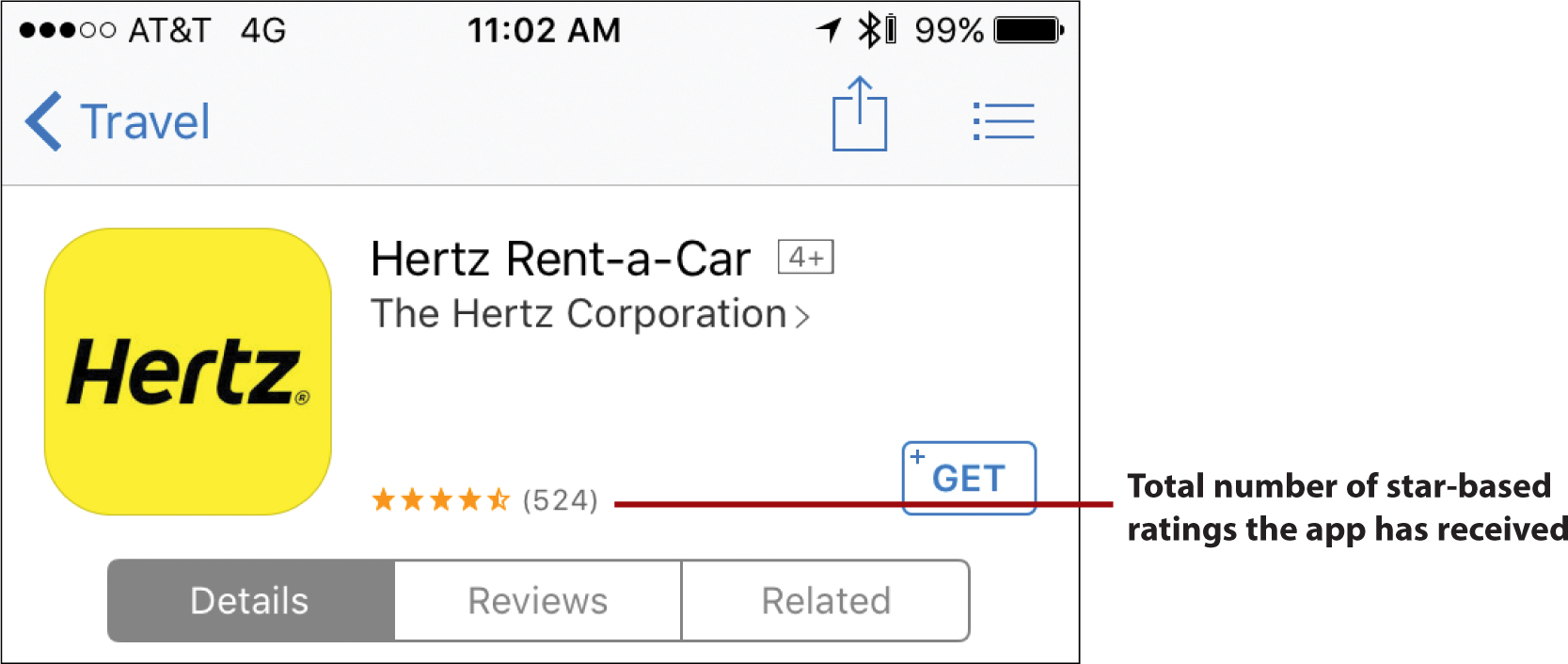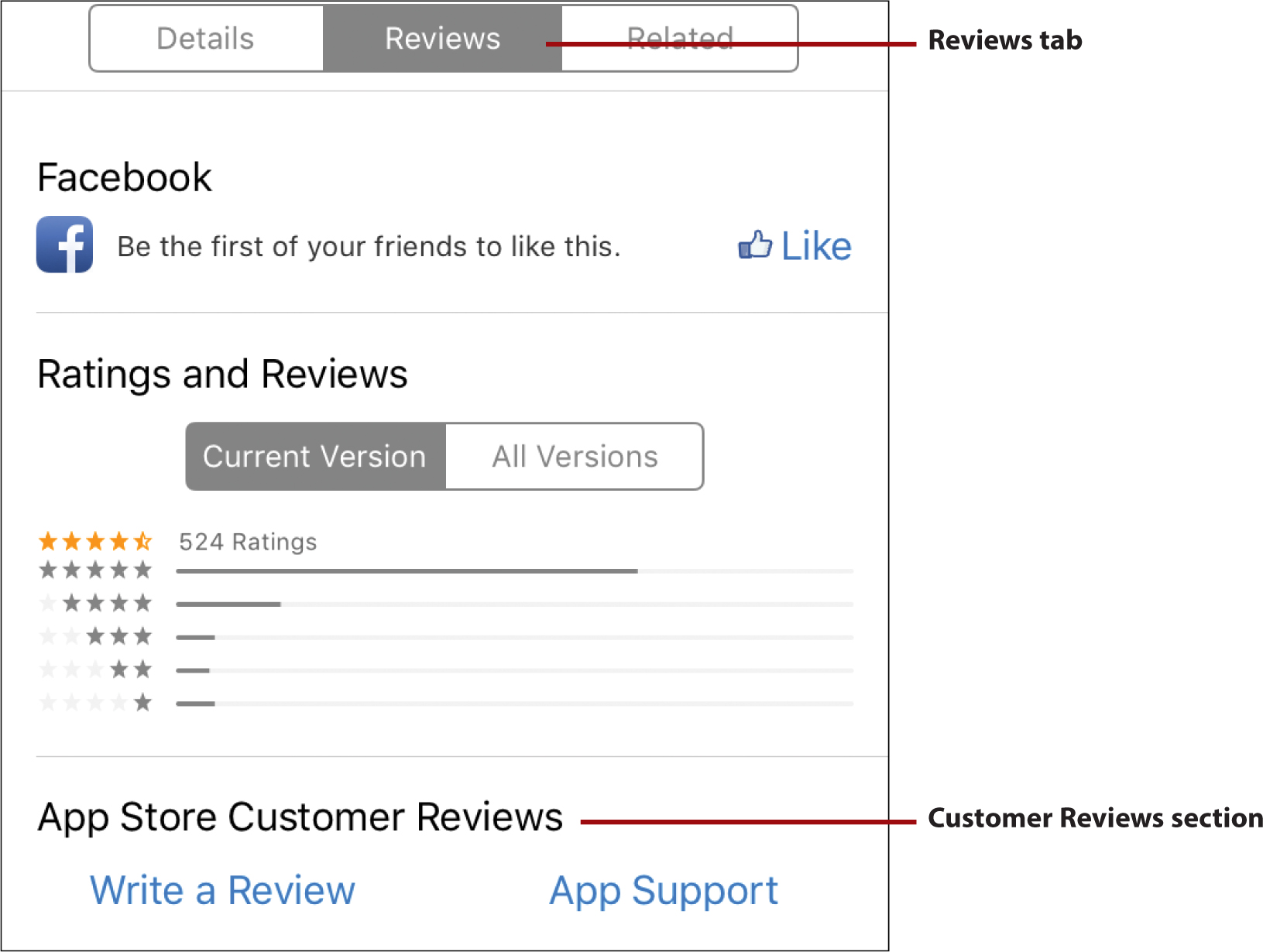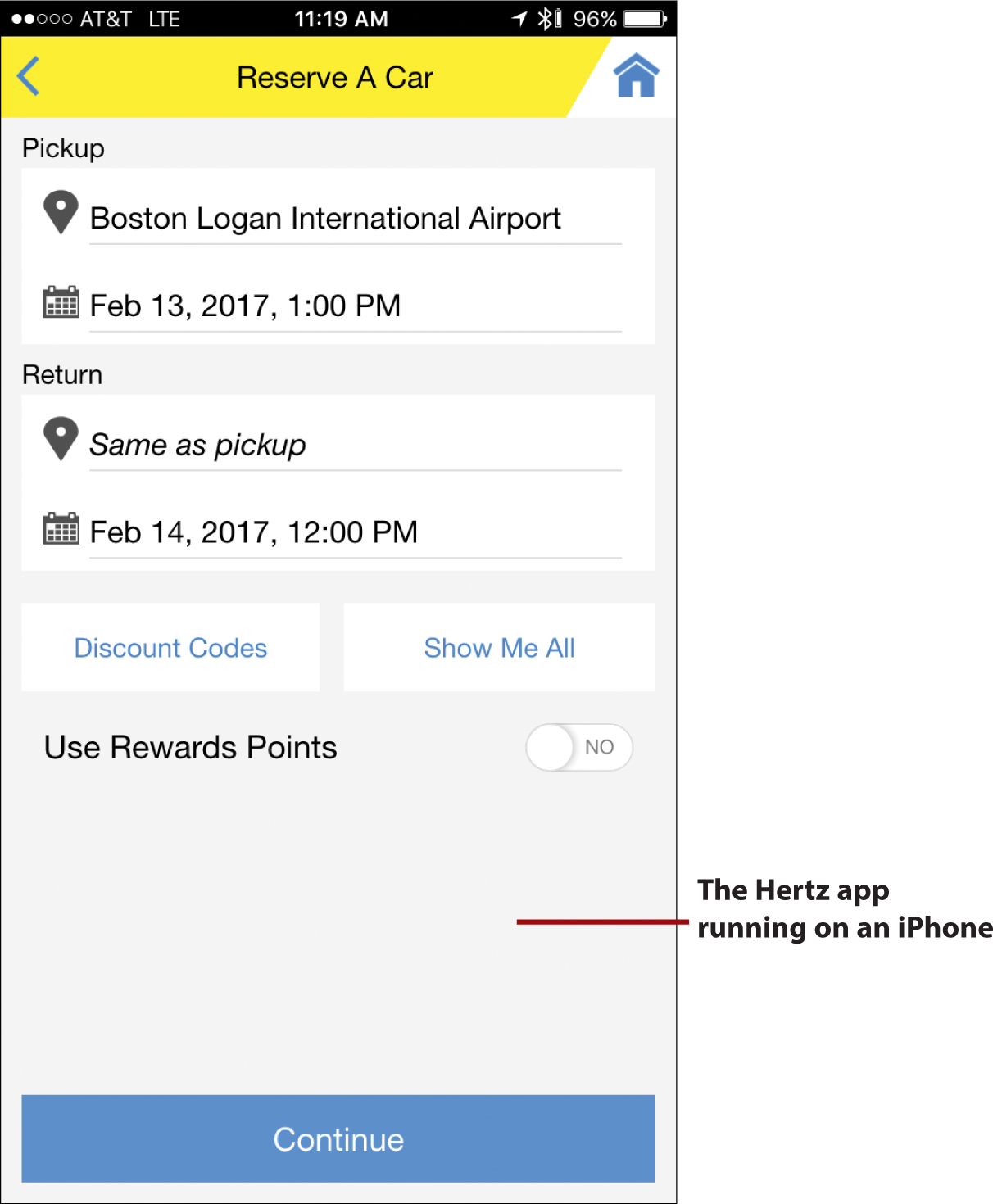1. Using Technology for Planning Travel
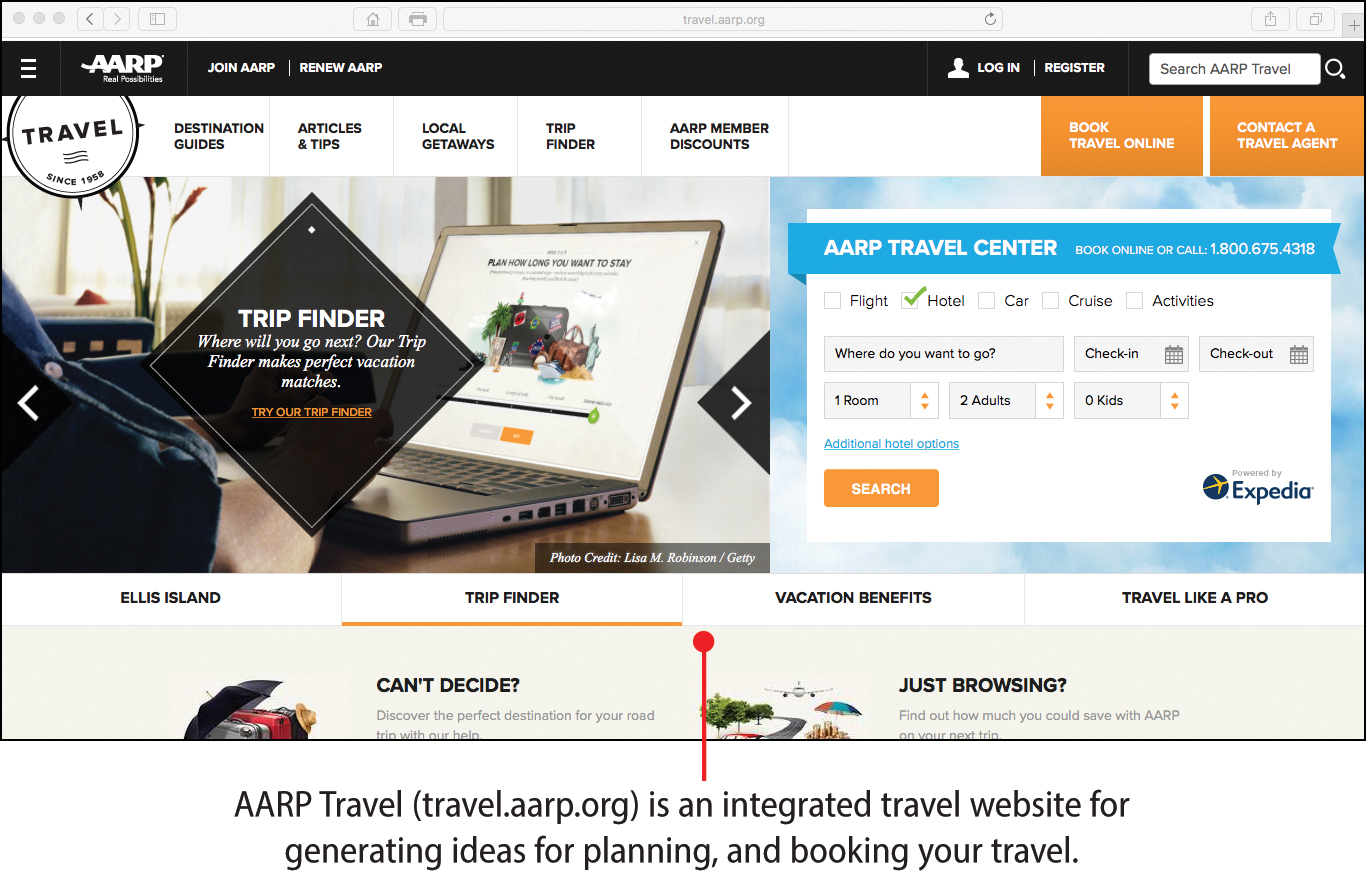
This chapter shows you ways to use your Internet-enabled computer, smartphone, and/or tablet to easily handle a range of travel-related tasks. You’ll discover
![]() How technology can help you make travel plans
How technology can help you make travel plans
![]() What equipment you’ll need to research, plan, book, and manage your trips
What equipment you’ll need to research, plan, book, and manage your trips
![]() What types of travel-related services are available via the Internet
What types of travel-related services are available via the Internet
![]() Ways you can save time and money planning trips using technology
Ways you can save time and money planning trips using technology
Travel enriches our lives. It opens the door to discovery, personal growth, wellness, and living our best lives. It connects us to family and friends. It’s no wonder people love to travel! Every year consumers spend billions of dollars on both domestic and international leisure travel: everything from weekend getaways and road trips to visits to relatives and friends to vacation dreams of a lifetime. People also travel for business, caregiving, medical procedures, sports, and life events such as weddings, graduations, and funerals.
Consumers Spend a Fortune on Leisure Travel
According to the U.S. Travel Association, in 2015, consumers around the world spent $650.8 billion on domestic and international travel, and 79 percent of all trips taken were for leisure travel. Americans took 1.7 billion leisure trips in 2015. The most popular reasons for leisure travel were to visit relatives, go shopping, visit friends, experience fine dining, and bask in the sun on a gorgeous beach.
As with most other aspects of our lives, technology has made travel easier, more convenient, and, in many cases, more affordable. Technology affects how consumers learn about travel opportunities and destinations; research travel plans; and book and pay for flights and trains, accommodations, rental cars, tours, and related services. While we’re on the go, technology can provide maps and navigation services, information about nearby attractions and restaurants, real-time language translation—even restroom locators. And during and after our trips, technology lets us share our experiences.
The technology that’s built in to your Internet-enabled smartphone, tablet, smart watch, or computer can serve as a powerful time- and money-saving tool when it comes to travel, and it also enables you to easily manage virtually all aspects of your trips and puts a tremendous amount of pertinent information at your fingertips.
Don’t Be Afraid of Technology
Thanks to technology, the travel industry has changed, and traditional travel agents play a smaller role. Today, instead of using the services of a travel agent, people are able to use their smartphones, tablets, and computers to manage travel-related tasks, including the following:
• Researching travel-related opportunities and destinations
• Obtaining trip-related recommendations/advice
• Planning a travel itinerary
• Shopping for the best prices and deals
• Making reservations for airfare, hotels, rental cars, tours, travel packages, and cruises
• Staying in touch with friends, family, and coworkers while traveling
• Sharing travel-related experiences and photos online via social media
There are some incredible benefits and conveniences that result from making your own travel arrangements. For example,
• Your travel itinerary can automatically be imported into the scheduling/calendar program you use on your computer.
• You can manage your whole trip using a trip-management service or mobile app, such as TripIt.com.
• You can be notified in real time on your smartphone, smartwatch, or tablet of flight delays, gate changes, bad weather conditions, or other changes to your itinerary as they happen.
If you’re new to using the Internet to make your travel plans, you might feel intimidated by the available choices or fear you’ll make a mistake. When it comes to overcoming mistakes and technology-related fears, My Digital Travel for Seniors can help you. Even if you don’t consider yourself to be tech-savvy, this book walks you through using your device to handle many common travel-related tasks—while saving time and money! You’ll also learn how to acquire the knowledge and confidence you need to effectively, securely, and safely use today’s technology to handle many aspects of travel and take advantage of free information, tools, and tips from AARP Travel (travel.aarp.org), whether or not you’re an AARP member.
What You Need to Get Started
To take advantage of technology to handle travel-related tasks, you need a device—computer, smartphone, or tablet—with Internet access. You can use any Windows-based PC or any Mac-based computer, whether it’s a desktop or notebook computer, for example, and any Android or Apple mobile device.
From your computer, you can then use any web browser, such as Chrome, Firefox, Microsoft Edge (Windows PCs), or Safari to access any of the travel-related online services and websites described in this book.

Remember, if you decide to manage various aspects of your travel from a smartphone or a tablet, the mobile device must have Internet access via a Wi-Fi or cellular data connection. Although you can use a mobile device’s built-in web browser to access online-based travel services and websites, you’ll typically find it much easier to use travel-related mobile apps, which you can download and install onto your mobile device. How to find, download, and install these mobile apps is explained later in this chapter, in the “Find, Download, and Install a Mobile App” section.
Your smartphone or tablet operates using a proprietary operating system—such as Android, iOS, or Windows Mobile—and comes with a handful of preinstalled apps. In addition, you can download and install other optional apps, which are independent programs that add specialized features or functionality to your mobile device.
Hundreds of optional travel-related mobile apps are available for your smartphone or tablet. Some optional mobile apps are free; others require you to pay a one-time fee to acquire them; and some are initially free but require you to make in-app purchases to make use of more robust features or functions.
You get apps for your mobile device from the online app store that’s associated with your device. For example, if you’re an iPhone or iPad user, to find, acquire, download, and install apps onto your device, launch the preinstalled App Store app. Internet connectivity is required.
Although all your travel information can be stored in your computer or mobile device, it’s often convenient to print out information, such as your travel itinerary, reservation confirmation letters, or airline boarding passes, so you have a hard copy readily accessible while on the go. To make this possible, you need a printer that connects to your computer, smartphone, or tablet.
When you have this common equipment at your disposal, you’ll need to access and use the various travel-related websites, online services, and mobile apps that are discussed throughout this book. The next section walks you through finding and downloading apps.
Find, Download, and Install a Mobile App
The app stores for the various devices include millions of apps that you can acquire, download, and install. Regardless of whether you use an Android, iOS, or Windows Mobile smartphone or tablet, finding, downloading, and installing optional apps works in pretty much the same way, although the look of the screens, menus, and app icons varies. The following steps outline how to find, download, and install an app onto an iPhone that’s running iOS 9. (If your iPhone/iPad is running the iOS 10 operating system, the steps to follow are virtually identical.)
![]() From the Home screen, launch the App Store app on your smartphone or tablet.
From the Home screen, launch the App Store app on your smartphone or tablet.

Use the App Store’s Search Field for iPhones and iPads
If you know the name of the app you’re looking for, launch the App Store app, tap the Search icon, and type the title of the app in the Search field. From the listing of search results, tap the desired app listing to view its app Description screen, and then skip to step 6.
![]() Tap the Featured icon, and then tap Categories.
Tap the Featured icon, and then tap Categories.
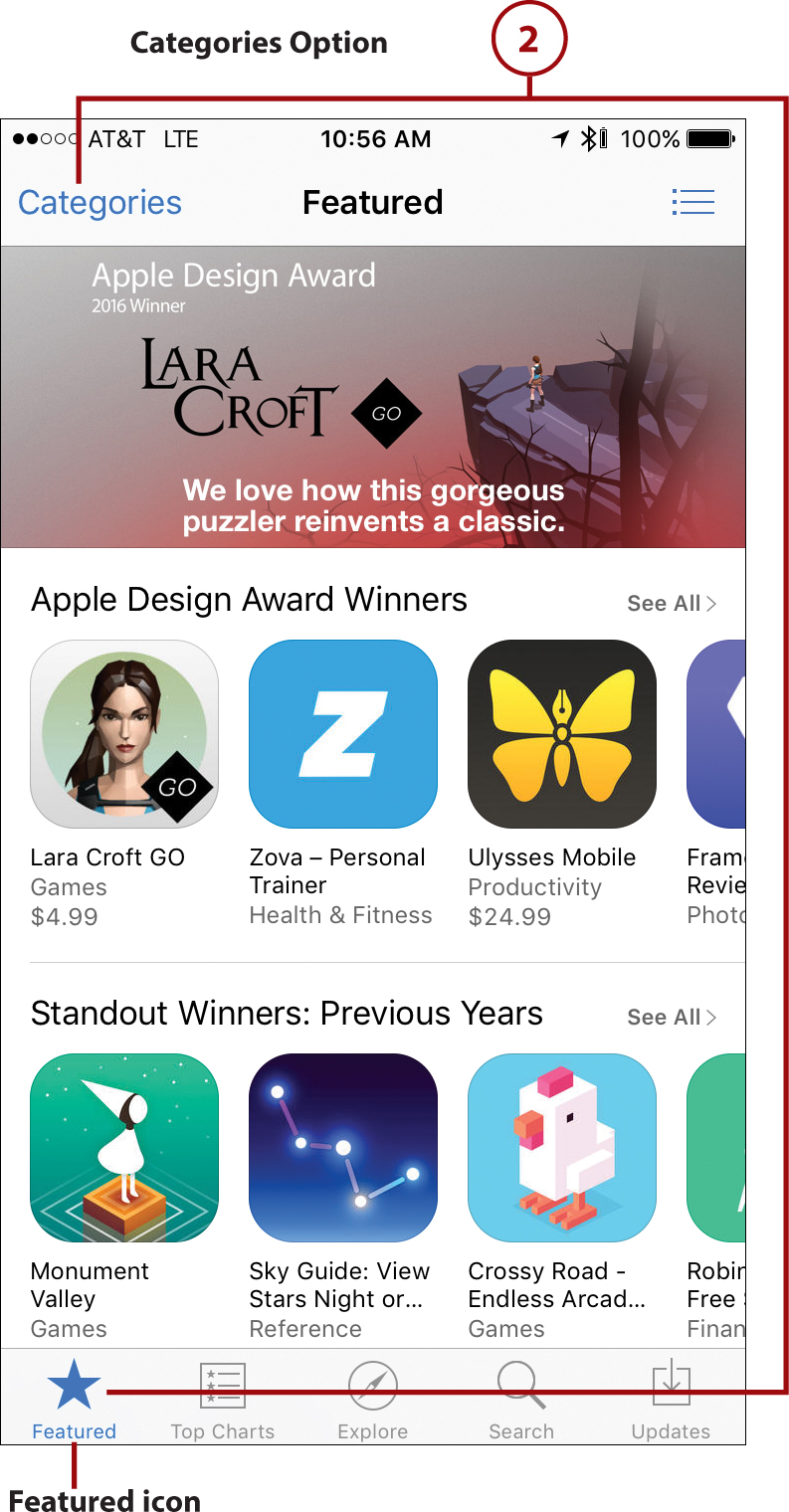
![]() Scroll through the Categories list, and tap Travel.
Scroll through the Categories list, and tap Travel.
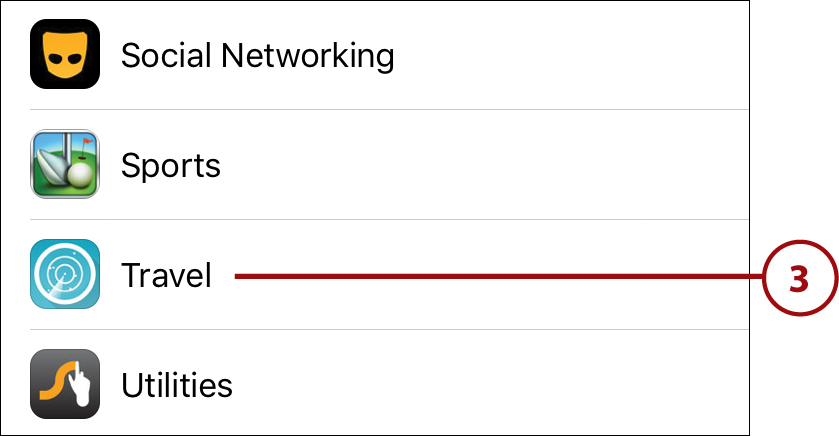
![]() Browse through the app listings in the Travel category. Swipe horizontally under a heading to scroll through app listings displayed under each specific heading, and swipe up to view additional headings.
Browse through the app listings in the Travel category. Swipe horizontally under a heading to scroll through app listings displayed under each specific heading, and swipe up to view additional headings.
Discover the Best Selling and Most Popular Travel Apps
To view listings for the most popular and best-selling travel-related apps, launch the App Store app and tap on the Top Charts icon. Tap on the Categories option, and then tap on the Travel category option. Tap on the Paid, Free, or Top grossing tab, and then scroll through the listing of apps, which are displayed starting with the most popular first. From the listing of search results, tap on the desired app listing to view its app Description screen, and then skip to step 6.
![]() Tap an app listing that’s of interest to view its Description screen.
Tap an app listing that’s of interest to view its Description screen.
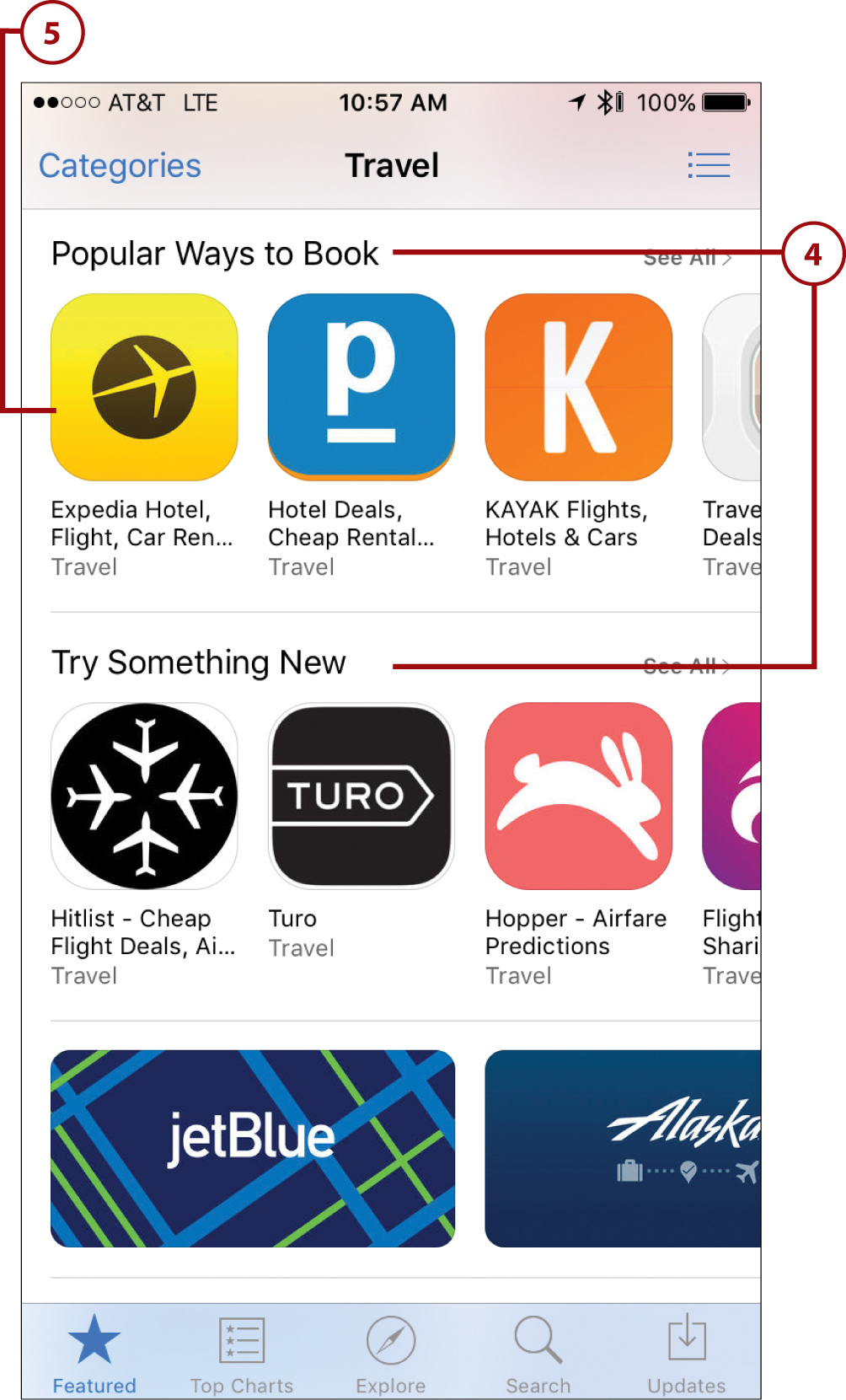
![]() Tap the Details tab to view sample screenshots from the app, and then swipe up to view a description of the app.
Tap the Details tab to view sample screenshots from the app, and then swipe up to view a description of the app.
![]() Tap the Get button (on free apps—the button says Price for paid apps) to begin the download and installation process.
Tap the Get button (on free apps—the button says Price for paid apps) to begin the download and installation process.
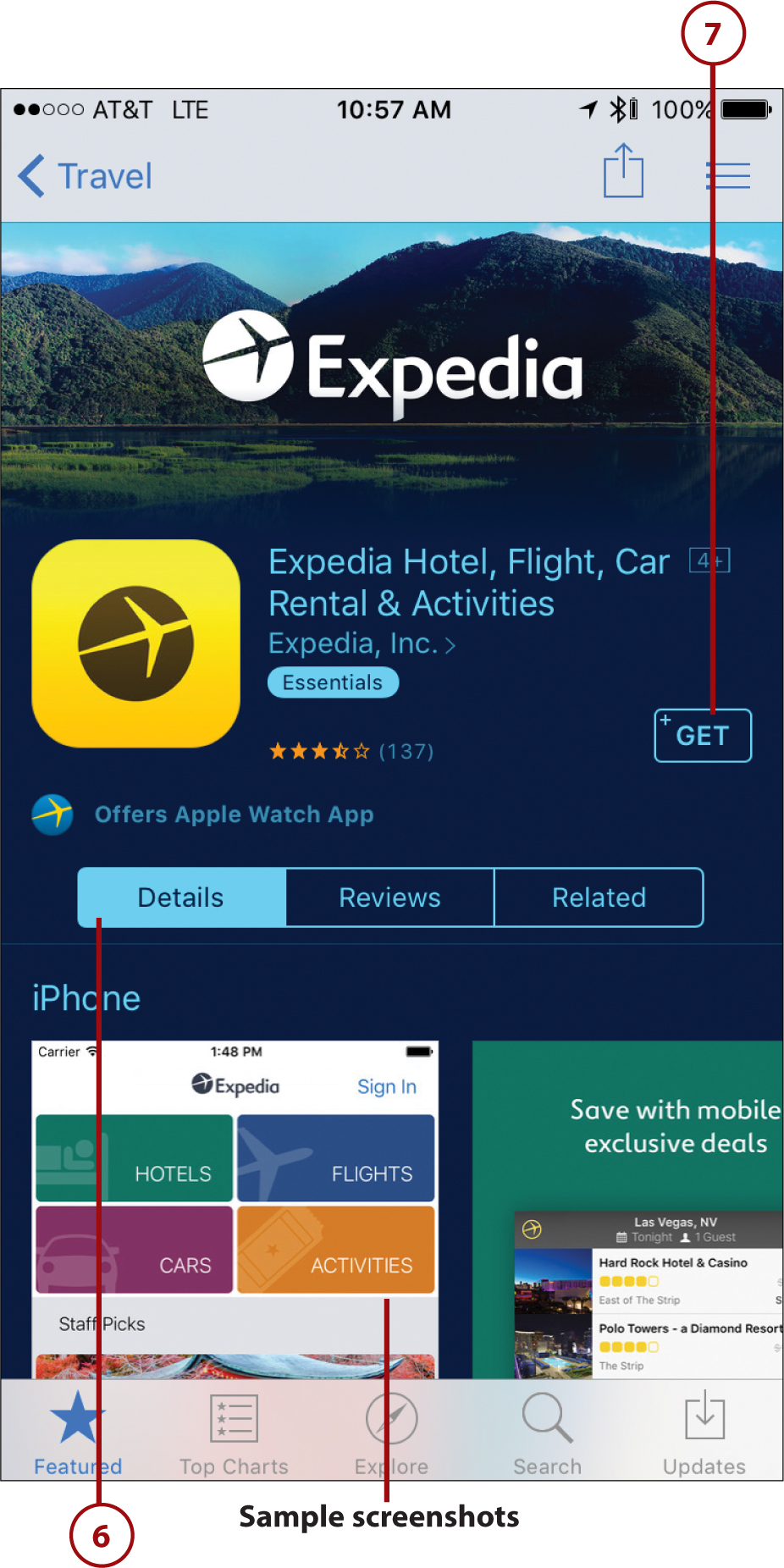
![]() Tap the Install button to confirm your decision. For paid apps, tap the Buy button to confirm your decision.
Tap the Install button to confirm your decision. For paid apps, tap the Buy button to confirm your decision.
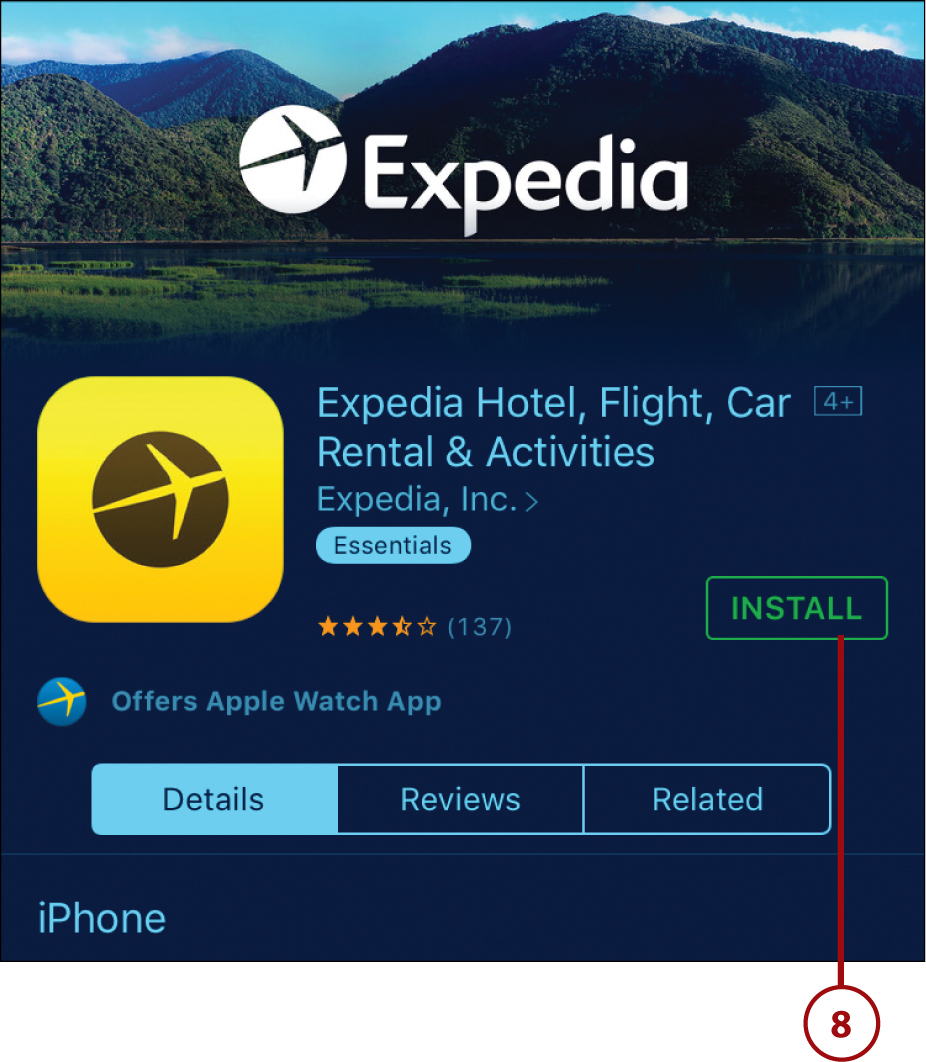
![]() Enter your Apple ID password, or place your finger on the iPhone or iPad’s Touch ID sensor to approve the acquisition. The app begins to download immediately after you’ve provided approval.
Enter your Apple ID password, or place your finger on the iPhone or iPad’s Touch ID sensor to approve the acquisition. The app begins to download immediately after you’ve provided approval.

![]() Tap the Open button to launch the app. Alternatively, return to the Home screen, and tap the app’s icon.
Tap the Open button to launch the app. Alternatively, return to the Home screen, and tap the app’s icon.
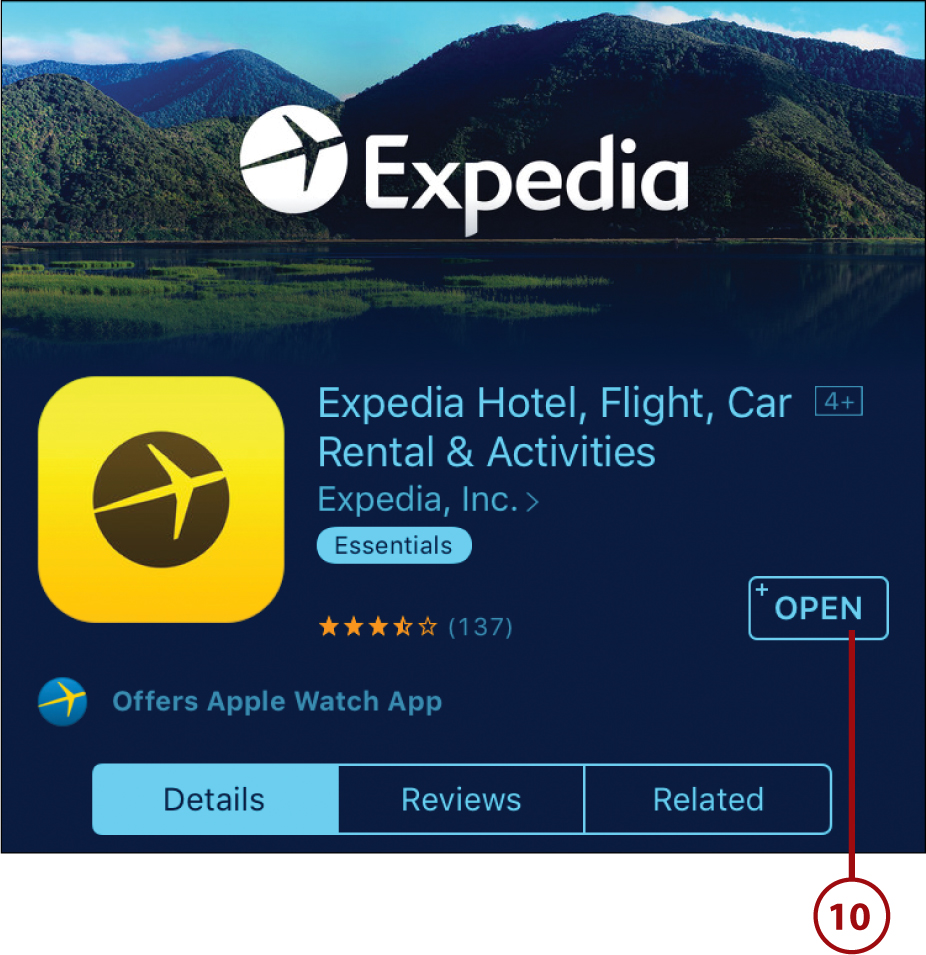
Working with a Desktop or Notebook Computer
Most of the travel-related tasks for which you’ll be using your computer will be online, and you’ll use your computer’s web browser. For example, to visit the online-based AARP Travel, launch your web browser, and in the address bar, type travel.aarp.org.
Visit Multiple Websites When Planning a Trip
According to research conducted by PhoCusWright, the average consumer visits 3.6 travel-related websites while shopping for an airline ticket. Using web browser bookmarks, you can store the website addresses (URLs) for your favorite travel-related websites, like travel.aarp.org, Booking.com, Hotwire.com, Travelocity.com, and Trivago.com, for quick and easy access later.
It’s a good idea to create bookmarks for the various online services and websites you use so you can return to them quickly in the future. To better organize your webpage bookmarks, consider creating a bookmark folder, called Travel, for example.
The process for creating a bookmarks folder and storing bookmarks varies based on which web browser you’re using. If you’re using the Safari web browser on a Mac, for example, select the Bookmarks menu and click the Add Bookmark option. Select the folder in which you want to store the bookmark and, if desired, edit the webpage title. Click the Add button to save that bookmark.
If you’re using the Microsoft Edge web browser on a Windows PC (running Windows 10), click the star-shaped Favorites icon. You’re then able to edit the Name field (which displays the name of the webpage), and adjust the Save In field (to determine in which folder the bookmark will be saved). Click the Add button to save the bookmark.

Later, when you want to revisit a bookmarked website, access your list of bookmarks, and click the desired website in the list.
Putting Travel Technology to Work
Between travel-related websites and online services you can access from your computer (via a web browser) or from your mobile device using a specialized app, many different travel-related tasks can easily be handled using technology.
Travel-Related Websites, Online Services, and Mobile Apps
Many online travel-related services (websites and mobile apps) were originally designed to handle specific tasks. But as these sites and services have evolved, the line between what the specific tasks are has blurred. In other words, more and more online travel services and mobile apps are striving to become a one-stop-shop for most or all of your needs.
Let’s take a quick look at some of the common tasks you can use your computer or mobile device to handle.
No Endorsements Are Implied
Throughout My Digital Travel for Seniors you’ll read about many services, websites, and mobile apps. What’s included in this book, however, is only a small sampling of what’s actually available to you.
The services, websites, and mobile apps featured in this book are included for demonstration purposes only. In many cases, the most popular services, websites, and mobile apps are described or featured. Inclusion should not be considered an endorsement by the book’s author, publisher, or AARP.
Researching Travel Destinations
Thanks to online and app-based travel guides, and countless digital travel magazines, online-based blogs, and destination-specific websites, as well as websites operated by the department of tourism for almost every city, country, and popular tourist destination in the world, as you’re doing your trip planning you can find tools and resources to help you determine where to go, when to go, how to fit your travel budget, what to see, and all manner of information about specific destinations, historical sites, and attractions.
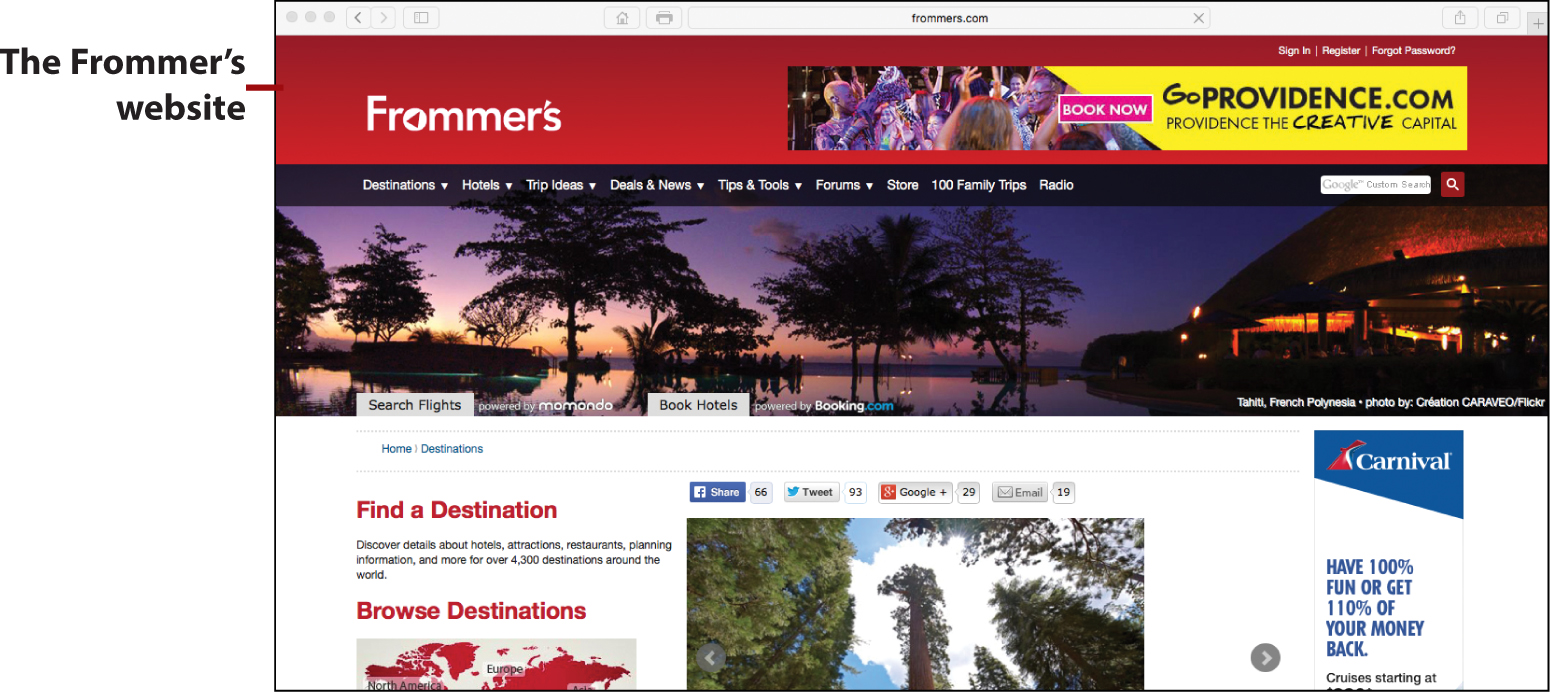
Finding and Booking Airline Tickets
When it comes to shopping for and booking airfares online, you can use an online travel agency website or service, such as travel.aarp.org, Hotwire.com, Orbitz.com, or Travelocity.com, that works with many different airlines and lets you compare prices among multiple airlines at once. You can also use a website or mobile app operated by a specific airline to shop for and book airline tickets from that airline.

Every Major Airline Has Its Own Website
Chapter 5, “Finding and Booking the Best Airfares,” introduces you to a handful of websites, online travel services, and mobile apps to use for shopping for and booking airline tickets.
Finding and Booking Hotels or Other Accommodations
In addition to popular online-based travel services like AAA Travel, AARP Travel, Hotwire, Orbitz, Priceline, or Travelocity, there are many online services (and mobile apps) dedicated to finding and booking hotel rooms, such as Booking.com, Hotels.com, and Trivago.com. If you prefer to stay at a hotel or a resort operated by a specific chain, such as Best Western, Choice Hotels, Hilton, Sheraton, or Starwood Hotels, you can visit the website or use the mobile app operated specifically by that hotel chain.

Use a Price Comparison Website to Save on Hotel Rooms
Many price-comparison websites allow you to choose a destination city, travel dates, number of beds needed, and a desired hotel/motel’s star rating, and then quickly browse through a selection of chain and independent hotels and motels, compare prices, and often save between 30 and 70 percent off published nightly room rates.
Keeping in mind that rooms rates fluctuate daily based on a variety of criteria including season and demand, to find the lowest hotel rates, always check with at least three different travel services and websites before making a reservation.
Some of these services require pre-payment in full, and do not allow changes or cancellations after the reservation is made. Others offer the capability to cancel or change the reservation, either for free or for a fee, so read the fine print carefully before booking your reservation. In some instances, you’ll find the lowest rate for a hotel directly from that hotel’s website rather than on a price comparison website.
To learn more about how to save money when booking a hotel using your computer, smartphone, or tablet, read Chapter 7, “Finding and Booking Accommodations.”
Finding and Booking Rental Cars
With services such as AAA Travel, AARP Travel, Hotwire, Orbitz, Priceline, or Travelocity, you can compare rental car prices among a handful of rental car companies in a specific city, or you can use a price-comparison service that deals only with car rentals, like AAA (www.rezserver.com/AAA-Travel), Carrentals.com, or Rentalcars.com. If you prefer to work with a specific car rental company, like Alamo, Avis, Budget, Dollar, Enterprise, Silvercar, or Thrifty, be sure to visit the website or use the mobile app for that specific company.
Discover Money-Saving Tips for Renting Cars
Be sure to read Chapter 6, “Finding Ground Transportation,” to learn how to use specific websites and mobile apps to find the best deals when renting a car. For example, you can often save an additional 10 to 20 percent on a rental car if you reserve the car online at the same time you make your airline or hotel reservation using a popular online travel service.
Finding and Booking All-Inclusive Resorts, Cruises, or Travel Packages
Along with the general travel-related websites and services that allow you to compare prices for airfares, hotels, and rental cars, there are niche services that focus more on all-inclusive resorts, cruises, and specialized travel (like safaris in Africa or travel packages for solo travelers).
Chapter 8, “Finding and Booking a Cruise,” covers how to find, book, and save money on cruise vacations, and Chapter 9, “Finding All-Inclusive Vacations and Vacation Package Deals,” addresses how to discover money-saving deals when booking all-inclusive resorts and other types of vacations.
Finding and Booking Tours and Attraction Tickets
Some of the popular travel websites allow you to research and book tours and attraction tickets at the same time you book your airfare, hotel, and/or rental car. There are also specialized services and mobile apps that focus specifically on finding and booking city-specific tours and localized attraction tickets. For example, with Viator.com, you can find and book a vast selection of tours and attraction tickets all over the world.
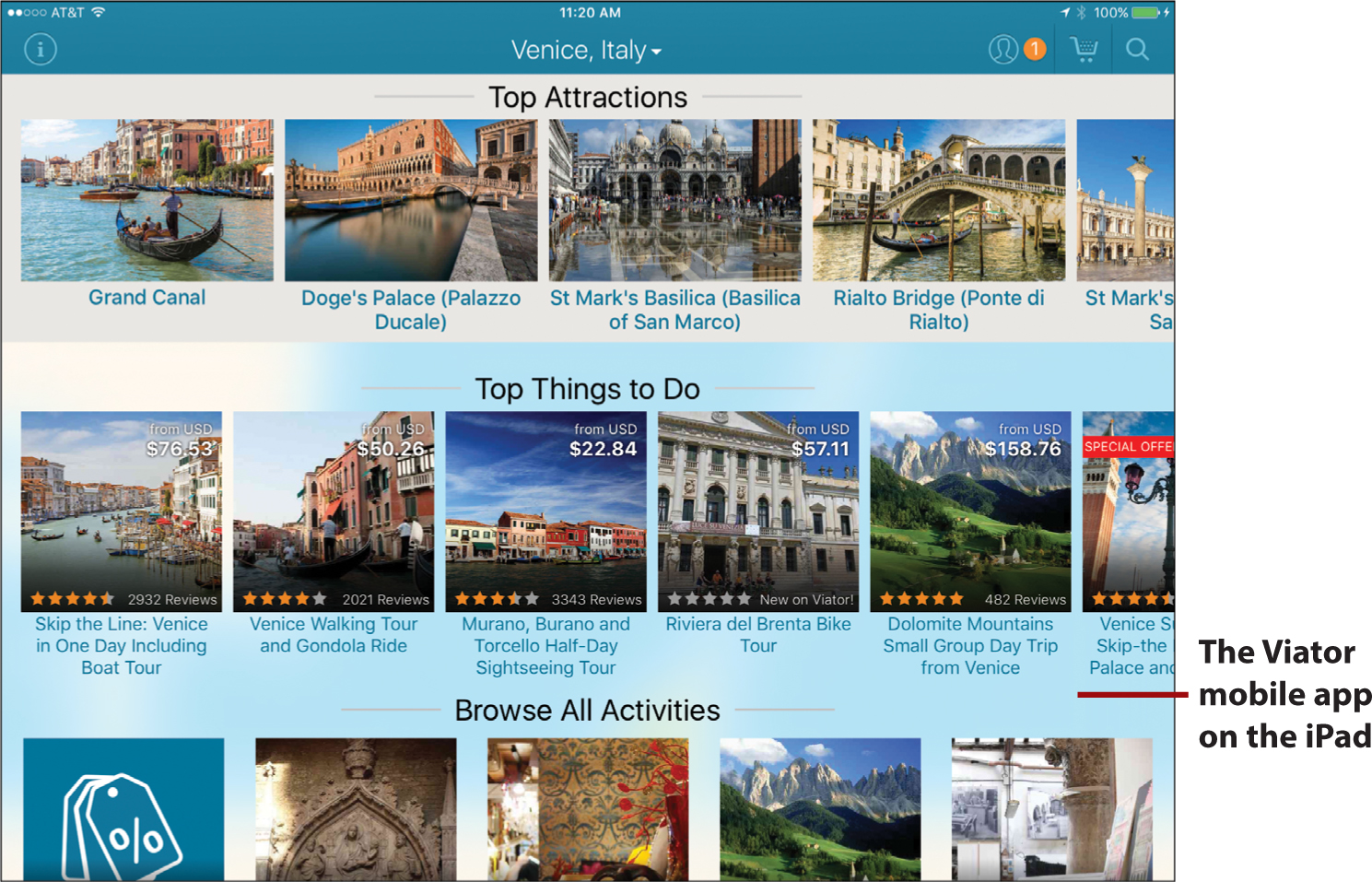
The Ship Mate app (https://shipmateapp.com) is ideal for finding and booking independently operated shore excursions associated with a cruise vacation. Sight-Seeing (www.city-sightseeing.com) offers hop-on/hop-off city tours in dozens of cities throughout the world.
Comparing Prices and Finding Travel Deals
In addition to individual price-comparison websites and online-based travel agencies, meta search sites, like Kayak.com, allow you to perform airfare, hotel, or rental car searches across dozens, or even hundreds, of individual travel websites at once. From there, you’re transferred to the website that’s offering the deal you’re looking for. In other words, these meta search sites help you find the best deals, and then direct you to the website(s) offering them.
Travelzoo.com Can Help You Find Travel Deals
Travelzoo.com (and the free Travelzoo mobile app) continuously scours the Internet in search of the very best travel deals and publishes its findings online. Every week Travelzoo contacts more than 1,000 travel providers and publishes a list of the top 20 best deals it finds. The Travelzoo Top 20 (www.travelzoo.com/top20) often lists money-saving offers for all-inclusive vacations and travel packages that include airfares, hotel, rental car, meals, tours, and admission to various attractions.
Reading Ratings and Reviews
Many services used for booking hotels and other travel services publish online reviews and ratings created by fellow travelers. In addition, online services like CruiseCritic, Family Vacation Critic, and TripAdvisor offer vast databases containing millions of consumer reviews of airlines, hotels, rental car companies, tourist attractions, tour operators, restaurants, and other travel-related services. Other mobile apps and websites, like Apple Maps, Google Maps, and Yelp!, also publish consumer-written reviews of local businesses, restaurants, local services, and attractions.
Purchasing Travel Insurance
Especially when traveling abroad, seriously consider acquiring travel insurance. Depending on the travel insurance you acquire from a company like Travelex or TravelGuard, you’re financially protected if you experience a medical emergency, missed flight, lost/delayed luggage, or your trip is delayed or cancelled due to weather. Travel insurance typically costs about five percent of your total trip price, and it offers a variety of benefits if something bad happens during a trip. Chapter 12, “Finding and Purchasing Travel Insurance,” offers information about how to purchase travel insurance from your computer or mobile device before you leave on a trip, as well as how to file a claim if the need arises.
Managing Your Travel Itineraries
Online-based services such as Tripit.com, as well as many different mobile apps such as FlightTrack Pro, let you manage your travel itineraries in real time. In addition to displaying your airfare, hotel, rental car, and tour details all in one place, these services alert you immediately if a flight is cancelled or delayed or if there’s a last-minute gate change at the airport. Many of these services and apps sync information directly with the calendar/scheduling program you already use on your computer or mobile device. You can find more information about these services and mobile apps in Chapter 13, “Services for Managing Travel Itineraries.”
Using Interactive Tour Guides and Navigation
Regardless of where you travel, chances are there’s a mobile app you can install onto your smartphone or tablet that serves as an interactive tour guide and assists you in navigating any city or tourist destination. To use these services and mobile apps, however, you have to have Internet connectivity for the GPS capabilities of your smartphone or tablet to work. So, if you’re traveling abroad, you’ll need to turn on international data roaming (which can be costly) or purchase a pre-paid SIM chip for a local cellular service provider in the country you’re visiting. More information about how to do this is covered in Chapter 14.
Using Language and Currency Translators
If you’ll be traveling to a foreign country where they speak a language in which you’re not fluent, consider one of the many optional mobile apps that serve as language translators. When using some of these apps, you simply type a word or sentence and the app translates it from one language to another. With other apps, you speak into the smartphone or tablet in your native language and the app translates in real time what you say into a selected foreign language. The mobile device then plays what you say in the selected language and displays the relevant text on the screen.
From the various app stores, you can also download currency-conversion apps that will come in handy when you’re abroad.
If you have some time before traveling overseas, you can check out online services and mobile apps that employ technology to help you more easily learn to speak a foreign language. Rosetta Stone is an example.
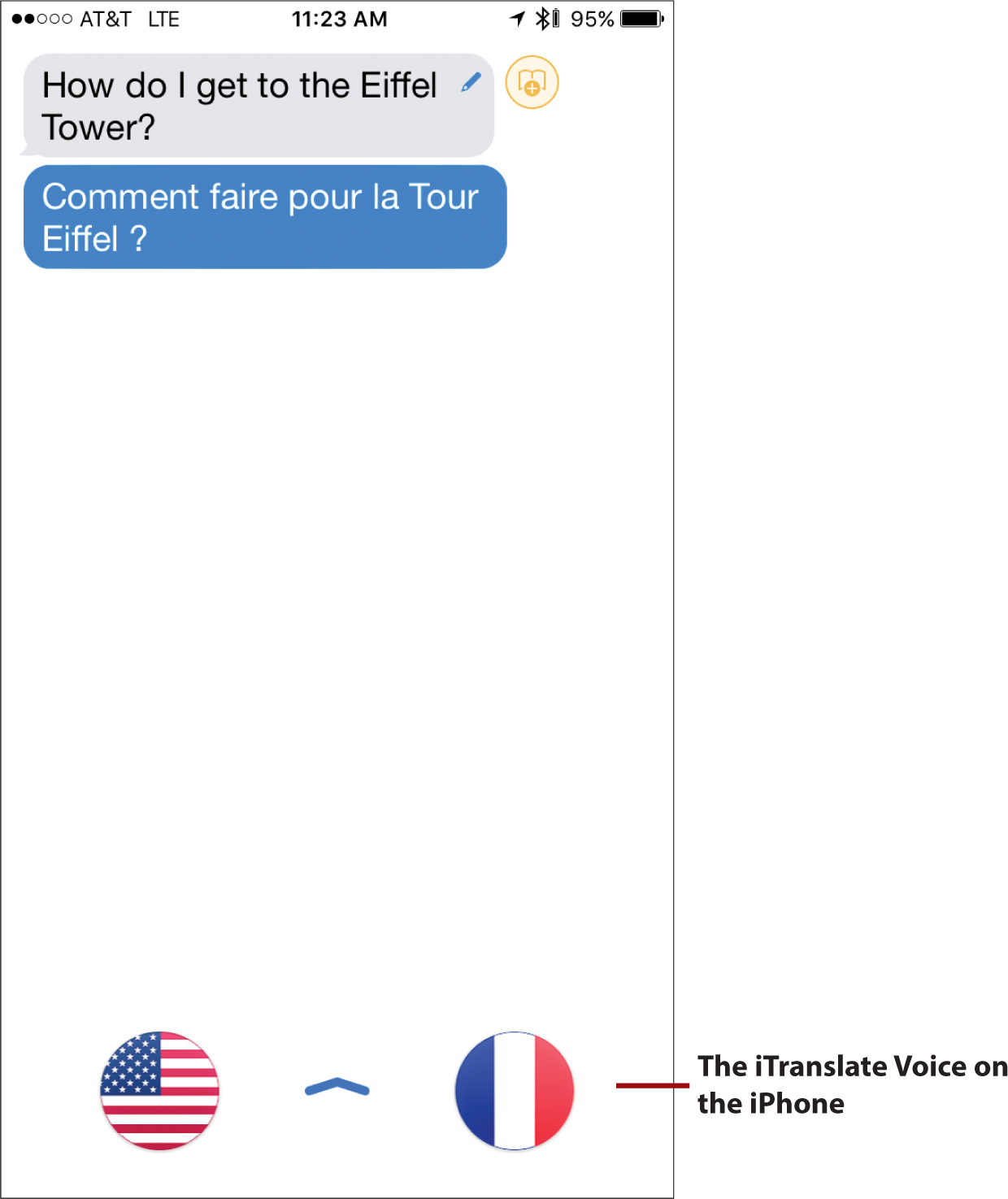
Connectivity for Language Translation and Currency Conversion
Most language-translator and currency-conversion apps require Internet access to function properly. Ideally, you need a cellular data connection so you can take advantage of these apps virtually anywhere. Keep in mind that these apps work just as well, and in some cases, faster if you’re within the signal radius of a Wi-Fi hotspot.
You’ll learn more about these websites and mobile apps in Chapter 10, “Mobile Apps to Use at Your Destination.”
Reviewing Travel Experiences
As you experience travel, you might want to share your own reviews and opinions with other travelers. If this is the case, you can set up a free account on services like CruiseCritic, TripAdvisor, Yelp!, or one of the travel websites that publishes reviews, and then write and publish your own thoughts, reviews, and opinions and post photos. Check out Chapter 15, “Chronicle and Share Your Experiences,” for step-by-step directions on how to publish and share your travel-related reviews and opinions.
Sharing Your Travel Photos Online
Using the cameras that are built in to your smartphone or tablet, it’s possible to take pictures during your travels and then instantly edit and publish them online via social media. Services like Facebook, Instagram, SnapChat, and Twitter, along with online photo-sharing services such as Flickr, Google Photos, PhotoBucket, and SmugMug, offer free and public forums for sharing your travel photos. In some cases you can also create photo albums or galleries and share them only with specific friends or family members that you specifically invite to view your images.
Using Technology to Become Your Own Travel Agent
Now that you’ve gathered the technology you need and understand some of the ways you can use your computer, smartphone, and tablet as a powerful travel-related tool, it’s time to become more technologically savvy and learn how to handle these tasks.
By following the directions and strategies in this book, in no time you’ll be able to confidently serve as your own travel agent, book and manage your own travel, save yourself money and time, and maintain peace of mind knowing that you’ve done your research and planning to find the best value.
Technology Will Help You Plan Your Trips
Research conducted by AARP showed people 50-plus spend between 30 and 36 hours a year online planning personal trips. Additionally, they spend about 18 hours a year online booking these trips. My Digital Travel for Seniors will help you maximize and possibly greatly reduce your time spent handling these tasks, while helping you become acquainted with how to best use the technology that’s available to you right now.
So, if you’re ready to get started planning your next road trip, weekend getaway, or trip of a lifetime, Chapter 2, “Researching Travel Opportunities,” explains how to use some of the online and mobile app tools available for helping you learn about potential travel destinations.

